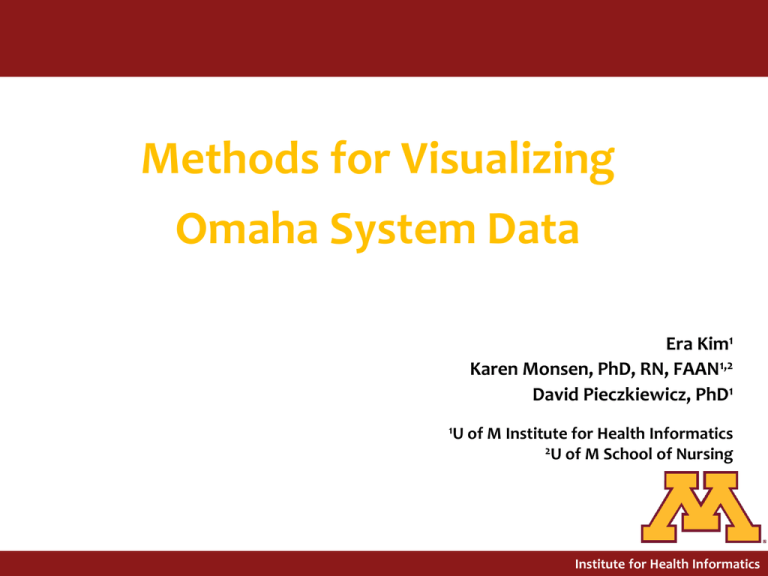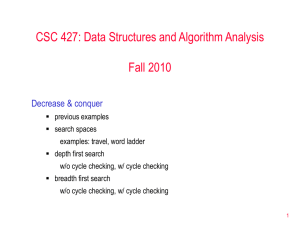Methods_for_Visualizing_Omaha_Sy
advertisement

Methods for Visualizing Omaha System Data Era Kim1 Karen Monsen, PhD, RN, FAAN1,2 David Pieczkiewicz, PhD1 1U of M Institute for Health Informatics 2U of M School of Nursing Institute for Health Informatics Introduction • Standardized classification for nursing interventions that consists of three components: problem, intervention, and outcome evaluation • Omaha System data: Rich and longitudinal Institute for Health Informatics Introduction • Rapid and intuitive pattern detection Human brain interprets graphical data more easily than numbers or text • Comprehensive and holistic data examination Statistical analysis alone can mask hidden patterns • Generate research questions in a data-driven way Surveillance Case Management Teaching/Counseling/Guidance Institute for Health Informatics Methods • Simple mechanism for use of Omaha System terminologies electronically to facilitate data processing and communication 6-digit alpha numeric code 2-digit prefix • PB for Problem • SS for Signs and Symptoms • CG for Intervention Category • TG for Intervention Target Example • Income problem, the 1st defined problem in Omaha System Income problem number P B 0 0 0 1 S S 0 1 0 1 Problem Problem number in the Omaha System Signs and Signs and Symptom number for income Symptoms problem in the Omaha System Institute for Health Informatics Methods • Easy to query • Normalization and relations Less dependency between entities and easy to maintain • Assured data consistency • Improved data quality • Used MySQL Workbench 5 Designed a logical model Exported a DDL (Data Definition Language) script to create physical database structure Institute for Health Informatics Methods CLEAN DATA EXTRACT DATA TRANSFORM & LOAD DATA INTO TARGET TABLE VALIDATE DATA • Migrate data from spreadsheets into the Omaha System Database • Use SQL statements and Java programs • Steps Clean data • Conduct visual data validation through the original spreadsheet data • Extract data • Load spreadsheets data into temporary tables Transform & Load data into target tables • Convert wide-format to long-format • Assure referential integrity and data consistency Validate data Institute for Health Informatics Methods 3-Tier Architecture (Client-Middle-Database tier) MVC (Model-View-Controller) design pattern using Java HTTP Web Application Server (Apache Tomcat 7.0) JDBC Omaha Database (MySQL 5) Stream Graphs drawn by • D3 • JavaScript Interactivity • Highlights • Tooltips Institute for Health Informatics Visualizing Omaha System Data • • • • A type of stacked graph where the baseline is free Layer indicates each category-target-problem triplet Layer thickness is determined by the frequency of each triplet Hue (base color), value (color brightness), and saturation (color deepness) encoded the Omaha System intervention category, intervention target, and problem, respectively Number of Interventions Surveillance Teaching/Counseling/Guidance Case Management Time Period between Patient Admission and Discharge Institute for Health Informatics Visualizing Omaha System Data Pattern differences between public health nurses were detected through visual inspection Institute for Health Informatics Visualizing Omaha System Data • Hue encodes the Omaha System problem Blue: Postpartum; Gray: Pregnancy; Magenta: Family Planning; Purple: Substance Use; Cyan: Abuse; Green: Caretaking/Parenting; Yellow: Mental Health; Orange: Residence; Red: Income • Value encodes the Omaha System intervention category example surveillance case management surveillance case management teaching, guidance, and counselling Number of Interventions Time Period between Patient Admission and Discharge Institute for Health Informatics Visualizing Omaha System Data Most graphs revealed that income and parenting problems persisted over time and interventions for the problems were rarely reduced in frequency Institute for Health Informatics Visualizing Omaha System Data status rating: 5 • A multi-level pie chart • Hue encodes the Omaha System problem • The first, second, and third circles from the center indicate patient knowledge, behavior, and status rating for a problem • Value encodes the Omaha System rating scores • The rim of the wheel indicates signs and symptoms of a problem and has a hierarchical relationship to the colored problem segment behavior rating: 4 Knowledge Rating: 3 sadness/hope lessness/decr eased selfesteem apprehension/ undefined fear purposeless activities difficulty managing stress income residence mental health caretaking/parenting abuse substance use family planning pregnancy postpartum Institute for Health Informatics Visualizing Omaha System Data The presence of mental health signs and symptom tends to associated with more diagnostic problems and worse patient condition MORE RISK LESS RISK Institute for Health Informatics Further Studies • Review and sort visualized data using online card sorting tool to detect differences • Generate hypotheses based on visual observations • Test them statistically • Evaluate the effectiveness of data visualization Institute for Health Informatics Q&A Institute for Health Informatics











